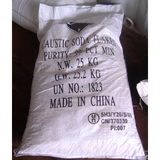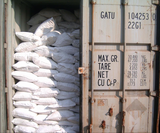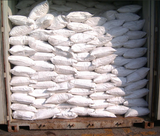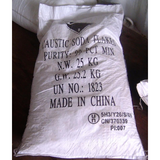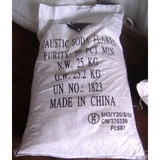Caustic Soda (sodium hydroxide) is a versatile alkali. Caustic soda is an essential ingredient in an array of industrial applications. Its main uses are in the manufacture of pulp and paper, alumina, soap and detergents, petroleum products, and chemical production. Other applications include water treatment, food, textiles, metal processing, mining, glass making, and others.
WHAT KEMCORE PROVIDES AS A PARTNER?
Reliable Supply
KEMCORE is always prepared to fulfill orders as they're placed and deliver the product customers need.
Commitment to Safety
KEMCORE has been safely and responsibly distributing Caustic Soda 99% (Flakes form) for decades and continues to make advancements through improved packaging options, on-site unloading services, and comprehensive training for our customers.
Dedicated Support
Whether it’s assisting with Caustic Soda handling or regulatory needs like licensing, permitting, and compliance monitoring, support is available.
COUNTRIES OF ORIGIN
- China
- Russia
Why Choose Kemcore's Caustic Soda Flakes?
- High Purity Caustic Soda Flakes
- Minimum concentration of 98,5% m/m NaOH
- Ionic Membrane- contains substantially less sodium chloride
- Free-flowing white flake pieces
Bye-Bye To Caustic Soda Purity Scams with our High Purity 99% Caustic Soda Flakes
Our Caustic soda lye is produced using membrane cell technology, concentrated up to the flake presentation using steam.
Supply Capacity
To meet the growing demand for Caustic soda flakes, we at Kemcore have partnered with low-cost producers to increase supply capacity and delivery dependability. Our production and caustic soda flakes suppliers are located in China. Our caustic soda flake prices reflect the quality that we supply.
Caustic Soda (flakes) uses
- Mining-Elution stripping of gold adsorbed onto activated carbon
- Manufacture of sodium salts
- Petroleum refining
- Manufacture of plastics
- Pulp and paper industry
- Dyes and pharmaceutical industries
- Aluminum processing
- Manufacture of soaps and detergents
COA & MSDS
You can download caustic soda flakes COA & MSDS sheet under “TECH DATA & SDS”
Caustic soda flakes specification - Ion Exchange Membrane
- NaOH ≥98.0
- SODIUM CARBONATE ≤ 1.0
- Sodium Chloride ≤ 0.05
- Oxidize the Iron ≤0.004
Molecular Formula: NaOH
CAS number: 1310-73-2
Physical Properties
Appearance: White, orthogonal crystals
Form: Colorless to white ... solid (flakes, beads, granular form).
Odor: Odorless
Boiling point: 1,388 °C
Melting/freezing point: 318 °C
Specific gravity: 2.13 @. 20°C
Flash point: Non-flammable
pH: 12.7 (1% aqueous solution)
FAQ:
1. Where is your caustic soda manufactured?
Our production and caustic soda flakes suppliers are located in China
2. How is your Caustic soda made?
Our Caustic soda lye is produced using membrane cell technology.
3. How many people have used it?
We have been exporting caustic soda to clients in Zimbabwe, South Africa, Tanzania, and other countries since 2007.
4. Are there quantifiable features?
Our caustic soda is of high purity with min 98.5%
Synonyms: Glacial acetic acid; Acetic acid solution; acetic acid 50%; acetic acid, of a concentration of more than 10 per cent, by weight, of acetic acid; Acetic Acid Glacial BP; Natural Acetic Acid; Acetic acid (36%); Acetic acid, food grade; Acetic Acid Glacial; GAA; Acetic Acid, Glacial
It is a colourless liquid that when undiluted is also called glacial acetic acid. It has a distinctive sour taste and pungent smell.
Acetic acid uses: Additive in industrial explosives in Mining.
Other uses include use of acetic acid in the production of vinyl acetate monomer, acetic anhydride and ester production.
Chemical gassing agents -In the case of emulsion explosives, using Acetic acid can accelerate the gassing process. The chemically gassed emulsions may take 40 – 50 minutes for completion of gassing within the blast holes, particularly when the emulsion is colder.
In cases where acetic acid is used, it is added to the emulsion prior to gassing, the desired amount of acid is mixed in the emulsion, before adding the gasser.
A gassing solution comprising sodium nitrite in water together with the selected enol compound and acetic acid is introduced into the emulsion explosive at the blast hole by entraining the gassing solution into a stream of the emulsion explosive using pumps.
The solution pH is an important parameter in the gassing of emulsion explosives due to the high cost associated with acid addition therefore a pH value should preferably be maintained at 4.1 or below.
|
Identifiers |
|
|
Abbreviations |
AcOH |
|
CAS number |
64-19-7 |
|
PubChem |
176 |
|
ChemSpider |
171 |
|
UNII |
Q40Q9N063P |
|
EC number |
200-580-7 |
|
UN number |
2789 |
|
Properties |
|
|
Molecular formula |
C2H4O2 |
|
Molar mass |
60.05 g mol |
|
Appearance |
Colourless liquid |
|
Odor |
Pungent/Vinegar-like |
|
Density |
1.049 g cm |
|
Melting point |
16 to 17 °C; 61 to 62 °F; 289 to 290 K |
|
Boiling point |
118 to 119 °C; 244 to 246 °F; 391 to 392 K |
|
Solubility inwater |
Miscible |
|
Acidity (pKa) |
4.76 |
|
Basicity (pKb) |
9.198 (basicity of acetate ion) |
|
Refractive index(nD) |
1.371 |
|
Viscosity |
1.22 mPa s |
|
Dipole moment |
1.74 D |
1- TRANSPORT INFORMATION
- Transport-UN 2789
- Hazard Class No. : 8
- Packing Group: II
- H.S. Code: 2915211900
2- STORAGE & HANDLING
- Stable at room temperature in closed containers under normal STORAGE & HANDLING and handling conditions. Refer to SDS sheet
3- PACKING
|
Packing type |
Tons/FCL |
|
IBC Drums |
18tons/FCL |
|
30kg Drums |
21tons/FCL |
|
200Kg drums |
16tons/FCL |
4.Environmental impact
- Acetic acid biodegrades readily under both aerobic and anaerobic conditions.
- Acetic acid does not absorb light with wavelengths >290 nm(4), and is not expected to be susceptible to direct photolysis by sunlight(SRC).
- Incase of spillage neutralize spill with soda ash or lime.
5. Download our Acetic acid msds for more handling information.







